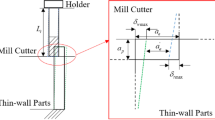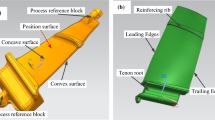Abstract
The service performance and life of the aero-engine are directly affected by the blade machining accuracy. In the end milling of the flexible blade, the profile tolerance would usually be violated by the deflection errors induced by excessive static deformations under the action of milling force. In order to predict the blade deflection errors, this paper presents an iterative algorithm considering the coupling relationship between milling force and elastic deformation based on the milling finite element simulation model. Then a novel multipoint rod-shaped auxiliary support technology is proposed to suppress the blade deflection errors. Taking the influence of layout parameters on blade deflection errors into account, the layout of auxiliary support is optimized by a genetic algorithm. To verify the effectiveness of the proposed method, an auxiliary support mechanism is designed and manufactured, and the deflection errors suppression experiment is implemented. The measured results show that the prediction error of blade maximum deflection is 17.6%. Furthermore, the blade average deflection error on two measured curves reduces from 45.88 μm to 24.39 μm with the support of the designed mechanism. Thus, this auxiliary support mechanism and layout optimization method can achieve higher accuracy in blade milling.























Similar content being viewed by others
References
Tao W, Cao YL, Yang JX (2015) Analysis of the influence of blade’s machining error on aerodynamic performance of impeller based on NUMECA. Procedia CIRP 27:155–163
Lim TS, Lee CM, Kim SW, Lee DW (2002) Evaluation of cutter orientations in 5-axis high speed milling of turbine blade. J Mater Process Technol 130-131:401–406
Ratchev S, Liu S, Huang W, Becker AA (2004) Milling error prediction and compensation in machining of low-rigidity parts. Int J Mach Tools Manuf 44:1629–1641
Ratchev S, Liu S, Becker AA (2005) Error compensation strategy in milling flexible thin-wall parts. J Mater Process Technol 162–163:673–681
Ratchev S, Liu S, Huang W, Becker AA (2006) An advanced FEA based force induced error compensation strategy in milling. Int J Mach Tools Manuf 46:542–551
Li ZL, Tuysuz O, Zhu LM, Altintas Y (2018) Surface form error prediction in five-axis flank milling of thin-walled parts. Int J Mach Tools Manuf 128:21–32
Chen WF, Xue JB, Tang DB, Chen H, Qu SP (2009) Deformation prediction and error compensation in multilayer milling processes for thin-walled parts. Int J Mach Tools Manuf 49:859–864
Hou YH, Zhang DH, Mei JW, Zhang Y, Luo M (2019) Geometric modelling of thin-walled blade based on compensation method of machining error and design intent. J Manuf Process 44:327–336
Altintas Y, Tuysuz O, Habibi M, Li ZL (2018) Virtual compensation of deflection errors in ball end milling of flexible blades. CIRP Ann 67:365–368
Huang T, Zhang XM, Ding H (2017) Tool orientation optimization for reduction of vibration and deformation in ball-end milling of thin-walled impeller blades. Procedia CIRP 58:210–215
Wang YF, Wong YS, Fuh JYH (1999) Off-line modelling and planning of optimal clamping forces for an intelligent fixturing system. Int J Mach Tools Manuf 39:253–271
Wan XJ, Zhang Y (2013) A novel approach to fixture layout optimization on maximizing dynamic machinability. Int J Mach Tools Manuf 70:32–44
Kulankara K, Satyanarayana S, Melkote SN (2002) Iterative fixture layout and clamping force optimization using the genetic algorithm. J Manuf Sci Eng Trans ASME 124:119–125
Dou JP, Wang XS, Wang L (2012) Machining fixture layout optimization under dynamic conditions based on evolutionary techniques. Int J Prod Res 50:4294–4315
Rai JK, Xirouchakis P (2008) Finite element method based machining simulation environment for analyzing part errors induced during milling of thin-walled components. Int J Mach Tools Manuf 48:629–643
Sun WY, Luo M, Zhang DH (2020) Machining vibration monitoring based on dynamic clamping force measuring in thin-walled components milling. Int J Adv Manuf Technol 107:2211–2226
Möhring HC, Wiederkehr P (2016) Intelligent fixtures for high performance machining. Procedia CIRP 46:383–390
Möhring HC, Wiederkehr P, Lerez C, Schmitz H, Goldau H, Czichy C (2016) Sensor integrated CFRP structures for intelligent fixtures. Procedia Technol 26:120–128
Iwabe H, Mizuochi M, Yokoyama K (1999) High accurate machining of thin wall shape workpiece by end mill proposal of twin spindle type machining and some experiments. Trans Japan Society Mechanical Eng 65(632):1719–1724
Wu DB, Wang H, Peng JS, Zhang KY, Yu J, Zheng XS, Chen YH (2020) Machining fixture for adaptive CNC machining process of near-net-shaped jet engine blade. Chin J Aeronaut 33:1311–1328
Ma JJ, Zhang DH, Wu BH, Luo M, Chen B (2016) Vibration suppression of thin-walled workpiece machining considering external damping properties based on magnetorheological fluids flexible fixture. Chin J Aeronaut 29:1074–1083
Luo HB, Zhao J, Li AH, Cui XB (2011) An experiment study on milling forces in high speed milling titanium alloy. Modular Mach Tool Autom Manuf Technique 05:18-20+25[Chinese]
Availability of data and materials
Not applicable.
Funding
This research was supported by the National Key R&D Program of China (No. 2020YFB1710400), the Natural Science Basic Research Program of Shaanxi (No. 2020JQ-183), and the Fundamental Research Funds for the Central Universities under Grant (No. 31020190502007).
Author information
Authors and Affiliations
Contributions
Baohai Wu: supervision, conceptualization, methodology, resources, and funding acquisition. Zhiyang Zheng: methodology, experimentation, data curation, and writing original draft. Jiao Wang: supervision and methodology. Zhao Zhang: supervision, reviewing and editing. Ying Zhang: supervision, reviewing and editing. All authors have read and agreed to the published version of the manuscript.
Corresponding author
Ethics declarations
Ethics approval
Not applicable.
Consent to participate
Not applicable.
Consent for publication
Applicable.
Conflict of interest
The authors declare no competing interests.
Additional information
Publisher’s note
Springer Nature remains neutral with regard to jurisdictional claims in published maps and institutional affiliations.
Rights and permissions
About this article
Cite this article
Wu, B., Zheng, Z., Wang, J. et al. Layout optimization of auxiliary support for deflection errors suppression in end milling of flexible blade. Int J Adv Manuf Technol 115, 1889–1905 (2021). https://doi.org/10.1007/s00170-021-07174-4
Received:
Accepted:
Published:
Issue Date:
DOI: https://doi.org/10.1007/s00170-021-07174-4




